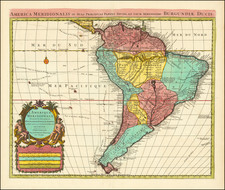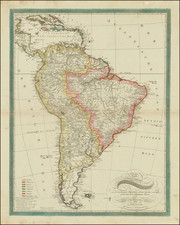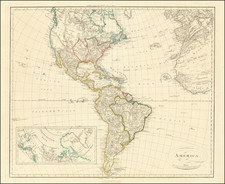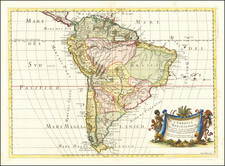Merian's edition of this rare view of the Island of Mocha in Chile, including an indigenous chiliquenes (Llama), copied from Olivier Van Noort's expedition narrative.
The island was historically inhabited by an indigenous coastal population of Mapuche, known as the Lafkenches. It was discovered by Juan Bautista Pastene, September 10, 1544, and named Isla de San Nicolas de Tolentino.
According to Juan Ignacio Molina, the Dutch captain Joris van Spilbergen, observed the use of chiliquenes (a llama type) by native Mapuches of Mocha Island, as plough animals in 1614.
Mocha Island was regularly visited by pirates from the Netherlands and England. Francis Drake and Olivier van Noort are known to have used the island as a supply base. When Drake was visiting it during his circumnavigation of the globe, he was seriously hurt by hostile Mapuches that inhabited the island. Eventually the Mapuche on the island were transported in 1685, from Mocha Island, by Governor José de Garro, to a reducción on the plain on the right bank of the Bio Bio River called the Valley of Mocha, that later became the location of the modern city of Concepcion, Chile.
Olivier van Noort (1558-1627) was the first Dutchman to circumnavigate the world. Van Noort left Rotterdam on July 2, 1598, with four ships and a plan to attack Spanish possessions in the Pacific and to trade with China and the Spice Islands. He initially landed at Rio Janeiro, Brazil, but was driven back, and along the coast suffered many losses by the attacks of the Indians. He resolved to winter in the deserted island of Santa Clara, then set sail again on June 2, 1599.
On June 29, 1599, he discovered an island near the coast of Patagonia, and stopped there to repair damages. On November 23, 1599, he entered the Strait of Magellan, and landed on the northern coast, where he was attacked by the Indians and again suffered many losses. Soon afterward he anchored among the Penguin islands, and subsequently he discovered the bays of Olivier, Mauritius, and Henry, but could not explore the latter on account of the ice.
On February, 1600, Van Noort and the remaining crew left the Strait of Magellan, and, entering the South sea, sailed along the Chilian and Peruvian coasts, pillaging and burning as he went, and capturing several Spanish ships. The viceroy, Luis Velasco, sent a fleet to capture him, but Noort had already set sail across the Pacific in the direction of the Ladrone Islands. He pillaged the Philippines, visited Java and Borneo, and, sailing round the Cape of Good Hope, arrived back in Rotterdam in August 26, 1601.
Van Noort returned to Rotterdam with only his last ship, the Mauritius, and 45 of his original crew of 248 men. The venture barely broke even, but was the inspiration for more such expeditions. The United Dutch East India Company (VOC) was formed a few months later. Van Noort's Description du Penible Voyage Faict entour de l'Univers ou Globe Terrestre, provides his account of the voyage, including a detailed account of the coasts of Brazil, Argentina, the Straits of Magellan, Chile, Peru and the subsequent Trans-Pacific Crossing.
Mathaus Merian (1593-1650) was the father of engraver Matthäus the Younger, and of the painter, engraver, and naturalist Maria Sibylla Merian. He was born in Basel, Switzerland and trained in engraving in Zurich. After a time in Nancy, Paris and Strasbourg, he settled in Frankfurt. While there, he worked for Johann Theodor de Bry, the publisher and son of the travel writer. In 1617, he married Maria Magdalena de Bry, Johann Theodor’s daughter. In 1623, Merian took over the de Bry publishing house upon the death of his father-in-law. Merian’s best known works are detailed town views which, due to their accuracy and artistry, form a valuable record of European urban life in the first half of the sixteenth century












![[The Rarest State] Americae Sive Novi Orbis Nova Descriptio](https://storage.googleapis.com/raremaps/img/small/80521.jpg)

